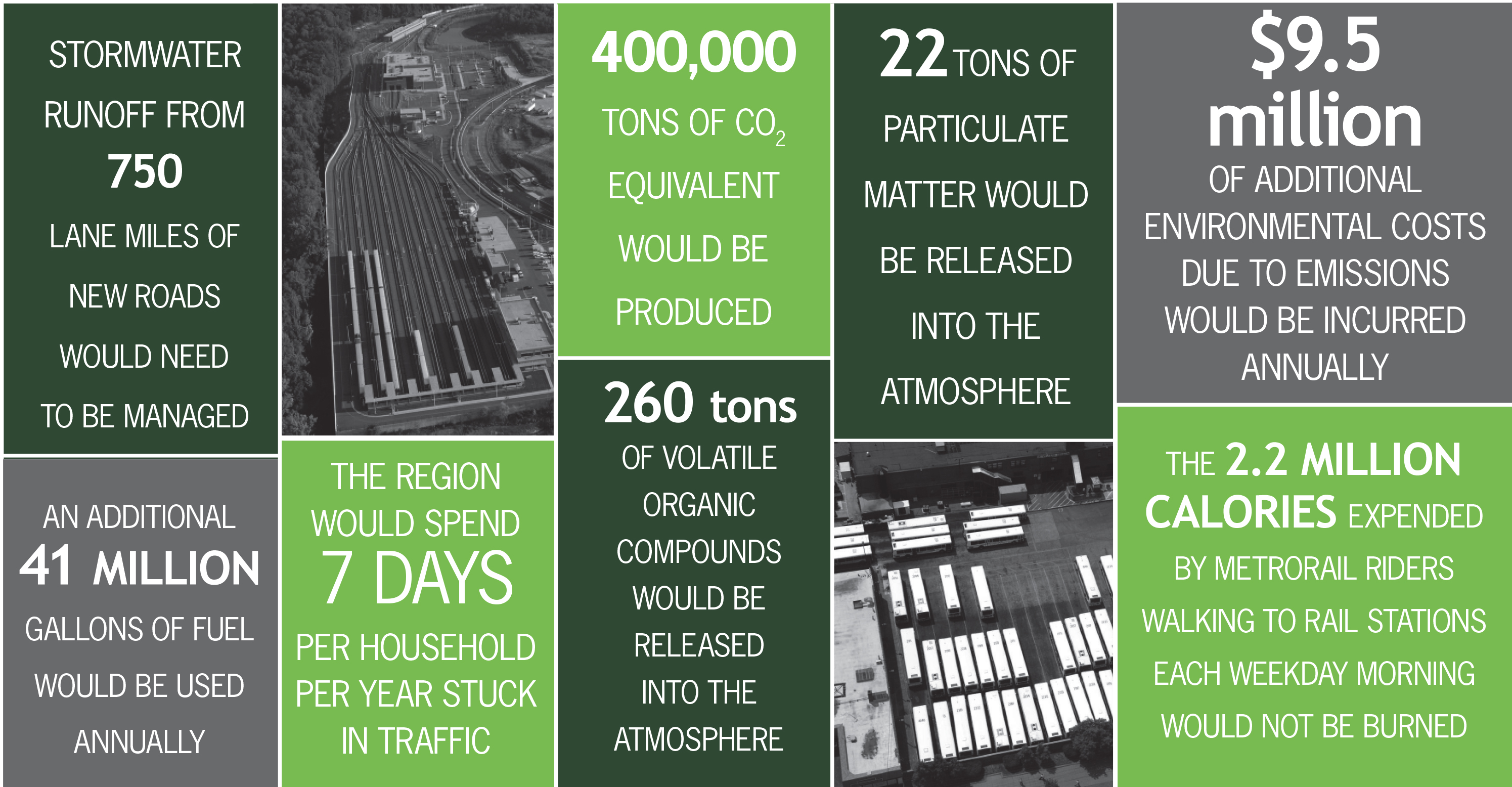
Environmental Impacts of Life Without Metro. Click for larger version.
Every time you ride Metrorail or Metrobus you make a positive impact on the region’s environment. As you can see, those positive impacts extend from the regions rivers and streams right through to the air we breathe every day. For example, without Metro:
- Stormwater runoff from 750 lane miles of new roads would need to be managed
- An additional 41 million gallons of fuel would be used annually
- The region would spend 7 days per household per year stuck in traffic
- 400,000 tons of CO2 equivalent would be produced
- 260 tons of volatile organic compounds would be released into the atmosphere
- 22 tons of particulate matter would be released into the atmosphere
- $9.5 million of additional environmental costs due to emissions would be incurred annually
- The 2.2 million calories expended by Metrorail riders walking to rail stations each weekday morning would not be burned
In particular, the positive impacts on air quality become increasingly important during the summer months when harmful ozone levels are at their highest. When it’s hot and sunny, volatile organic compounds (VOCs) from vehicle emissions react and produce low-level ozone that dramatically reduces air quality precisely when the weather is good and people are outside taking advantage of this. So with summer around the corner taking Metro never made more sense. To see some more detail on the environmental value of transit and Metro to the region check out the details here Making the Case for Transit: WMATA Regional Benefits of Transit Report.
This post forms part of a series featuring content from Metro’s Sustainability Agenda, part of Metro’s Sustainability Initiative.
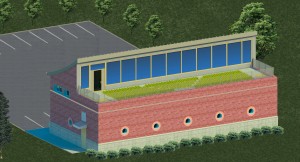
Net Zero Water Treatment Facility
Near the Largo Town Center Metrorail Station, Metro is constructing a water treatment facility that features a modular green roof system and rain garden to filter stormwater. The facility will manage subsurface water from the track bed and has been designed with photovoltaic panels and battery storage system to achieve net zero energy specifications. Designing the facility to net zero means the building will produce as much energy as it needs on-site, without drawing power from the electric grid, to perform the entire subsurface water treatment process.
Currently, in accordance with State of Maryland requirements, track bed water at the station is treated to balance acidity and sulfate solids prior to being discharged into the storm sewer system. New regulations require Metro to undertake more comprehensive stormwater treatment to remove also remove iron and suspended solids. Initially, expanding the current underground water treatment facility at the site was considered. However, the existing location did not have sufficient space to allow the new requirements to be met and a new treatment facility was necessary. The new treatment facility will utilize three large submersible pumps to transport the stormwater to the surface for treatment. Pumping the water to the surface presented new process load requirements, but to address these the facility has been designed with a gravity feed system that uses less energy over the life of the project to perform the water treatment process. In addition, the facility also showcases a host of operating cost reducing green building technologies, including: Read more…

Wayside Storage Battery Power System
For more than 20 years, Metro’s rail cars have captured and reused some of the electric energy that would otherwise be wasted when they brake through a process called regenerative braking. This process converts the excess kinetic energy, as the vehicle slows, to electric energy which can be stored and reused for propulsion power. Building on this technology, Metro recently completed tests to capture and utilize even more of the energy during braking through wayside battery storage.
The pilot project tests the energy storage efficiency and return on investment of a wayside Battery Power System (BPS). The BPS uses an innovative nickel-metal hydride battery that is characterized by low internal resistance. As a consequence, the battery can charge and discharge in a matter of seconds, making it perfect for wayside applications where rapid storage and discharge of propulsion power is required. Through this BPS storage system, the kinetic energy that would previously have been dissipated as waste heat can now be productively reused to power railcars and reduce overall energy consumption. Read more…
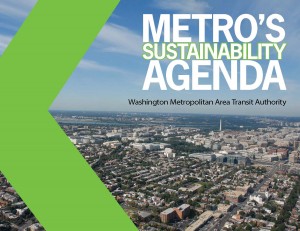
Metro’s Sustainability Agenda
To coincide with today’s Earth Day we are excited to announce the launch of the Metro’s Sustainability Initiative. Last spring Metro’s Board of Directors adopted Momentum, Metro’s strategic plan, committing Metro to sustainability. As a companion to Momentum, Metro’s Sustainability Initiative sets out Metro’s plan to meet that commitment through 2025 and beyond and positions the Authority to enhance regional livability while providing service more efficiently.
Check out Metro’s Sustainability Agenda a publication that highlights Metro’s sustainability investments to date, sets forth regional and internal sustainability performance targets, and outlines future actions that can help meet these targets.
Performance targets include:
- Increasing Metro ridership 25% by 2025
- Increasing greenhouse gas displacement 10% by 2025
- Reducing energy use per vehicle mile 15% by 2025, and cutting in half greenhouse gas emissions per vehicle mile during the same timeframe
- Reducing water use per vehicle mile 20% by 2025
Read more…
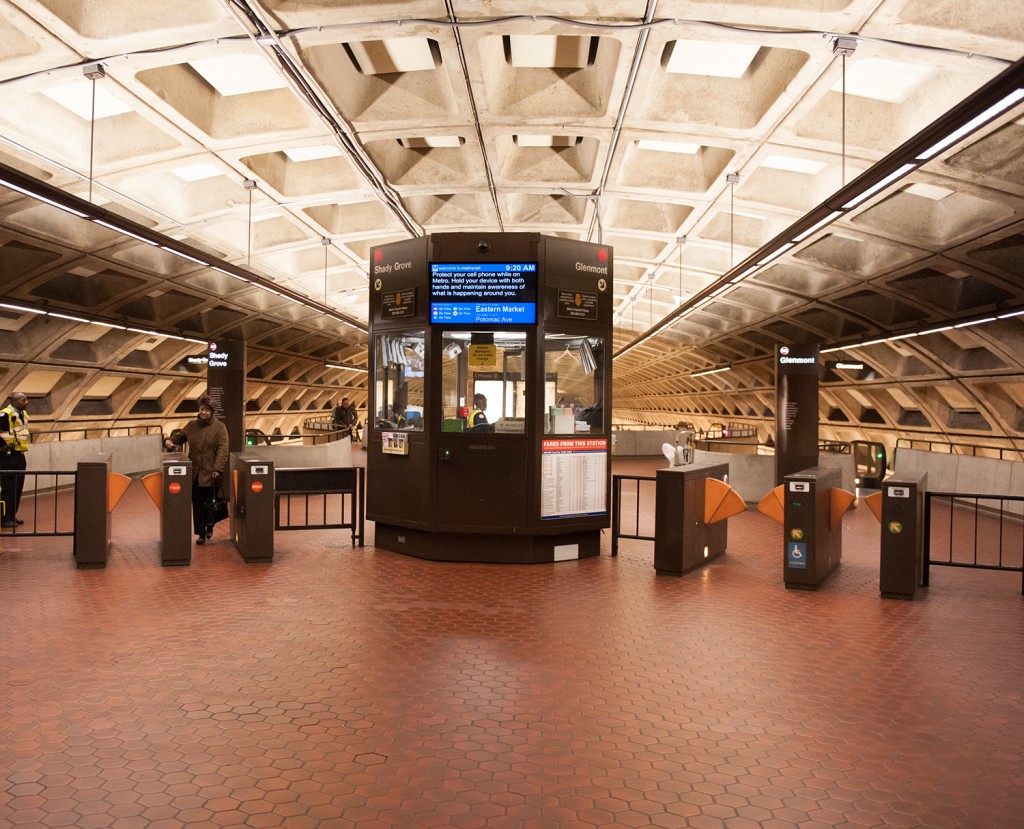
New Station Lighting at Judiciary Square. Click image for larger version.
Pilot upgrades using energy-efficient lighting at three stations have been a success, so Metro is planning to ramp up the effort to 41 more stations by 2015.
Metro recently completed retrofitting the mezzanine-level lights at Judiciary Square, Gallery Place, Bethesda, Smithsonian and Metro Center. Through careful fixture selection, the new fixtures provide a higher quality of light with an improved Color Rendering Index (CRI) thereby improving both lighting levels and overall visibility. Significantly, the new lighting design offers better light levels without compromising the integrity of the original lighting design and station aesthetic. The retrofits also provide significant lifecycle cost savings for Metro through reduced energy consumption and maintenance requirements.
Following these successes, Metro General Manager/CEO Richard Sarles today that it plans to upgrade mezzanine lighting at the 41 remaining underground Metrorail stations by 2015. In addition to the five already completed stations, one station, L’Enfant Plaza is currently under construction. Read more…
Metro requests feedback on draft Greenhouse Gas (GHG) calculator.
As part of the 40 Days of Momentum, a recent blog post the importance of Metro to the region, including greenhouse gas (GHGs) emissions reductions. Now it is your turn to look up your share of those GHG reductions.
Please try out our draft Greenhouse Gas Calculator, which asks for a starting and ending address, and then routes your trip via automobile and transit and displays the route and GHG emissions differences.* We are soft-launching this tool to crowd-source the quality assurance process and assess its usefulness.
Launch the GHG Emissions Savings Calculator!
What other features would you like to see? Did the tool accurately portray your travel choices? What is the difference in GHGs between driving and transit for your most frequent trip?
* Note on GHG calculations: the tool uses the Google Directions API to route your trip using both automobile and transit. The Google Directions API response includes each step of the journey, including mode and distance. We apply standard rates of GHG emissions per mile to the different modes used. As an added bonus, if your transit trip includes walking, we toss in an estimate of the calories you burned too!
Metro’s newest facilities show commitment to sustainability.
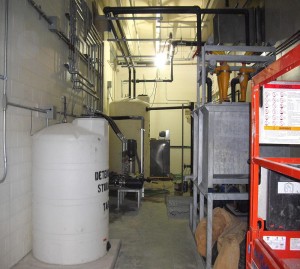
A bus wash reclaim room at Shepherd Parkway houses tanks that refilter water from the bus wash to be reused.
When it comes to constructing environmentally friendly facilities for employees and customers while reducing energy and lifecycle costs, Metro is taking the lead—LEED (Leadership in Energy and Environmental Design) certification, that is. As of September 2012, Metro has constructed two facilities that are LEED Silver certified— Glenmont Parking Garage and Shepherd Parkway Bus Facility – an extra effort that is well worth it.
“Sustainable facilities offer functional, comfortable and attractive environments for our employees who work there and for paying customers who use them daily,” said Edward Shepperson, Project Manager during the construction of both facilities and Contracting Officer’s Technical Representative (COTR) at WMATA. “WMATA will realize benefits through energy savings, improved employee morale and expand the public’s perception of WMATA, not only as a leader in transportation, but also as a responsible custodian of the environment.”
LEED is a U.S. Green Building Council (USGBC) program that provides third-party verification of green buildings through a rating system. Building projects earn points based on environmental impacts and human benefits of sustainable construction practices. In constructing the Shepherd Parkway Bus facility, WMATA earned points towards its LEED Silver certification for using recycled building materials, and recycling water through a large reservoir when washing buses. Read more…
Health and sustainability lead to the greening of Metro’s custodial services.

Estelle Strickland, PLNT, washing the glass partitions at Twinbrook station on July 4, 2010
Metro’s Grounds Maintenance and Custodial Services (GMAC) staff are doing much more than keeping the system clean, safe and sanitary for customers and fellow employees. They are going green and improving WMATA’s bottom line through their Green Cleaning Program—an initiative focused on cleaning for health and sustainability.
“Our efforts have included initiating cleaning practices that have a positive impact on the environment, that are less harmful to our internal and external customers and generate financial savings where possible for the Authority,” said Christopher Moore, Superintendent, Office of Plant Maintenance (PLNT).
The primary cleaning solution PLNT uses is a Green Seal-certified chemical that is dispensed through an automatic dilution control device, allowing a custodian to set a dial that dispenses a cleaning solution that mixes with water for cleaning carpets, glass, floors and other surfaces, each at the appropriate water-to-solution ratio. This allows Metro to save money by stocking less chemical in store rooms and reducing handling costs. The solution is also cold-water activated, generating substantial energy cost savings for the Authority by not requiring the use of hot water. Read more…
In recent years, the fuel efficiency of the Metrobus fleet has significantly improved, reducing Metro’s fuel expenses, and improving Metro’s environmental sustainability.
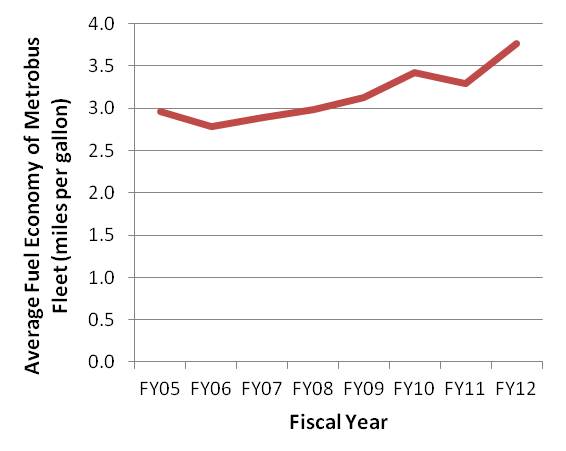
Metro’s bus fuel efficiency has increased by 27% over the past eight years, reducing fuel costs and improving environmental sustainability.
Over the past 8 years, the average fuel economy of Metro’s bus fleet has increased by 27%, from 2.96 miles per gallon (MPG) to 3.76 MPG today. The chart at right illustrates this trend, using actual odometer and fuel readings which are gathered and stored by our bus technology group.(Note that these figures include the consumption of compressed natural gas [CNG], expressed as gallon-equivalents. The slight dip in FY2011 is the result of some data loss during a transition to an electronic mileage tracking system.)
What is Causing this Trend? This steady increase in fuel economy is generally the result of technological improvements in the fleet. Metro has been replacing older standard diesel buses with newer diesel-electric hybrid, CNG, and clean diesel models. In particular, introducing diesel-electric hybrid buses to the fleet has helped push up the average: on the streets today, our diesel-electric hybrid fleets are achieving average mileage of 4.49 MPG. Metro purchased its first hybrid bus fleet in 2006, and today these buses provide 41% of Metro’s bus vehicle-miles.commercial jumping castle for sale
Read more…










Recent Comments